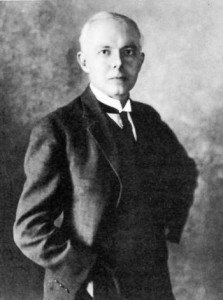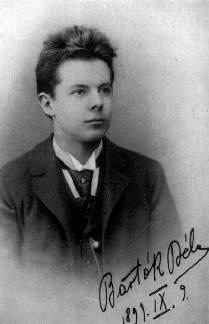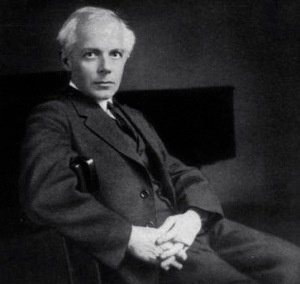IN MEMORIAM BÉLA BARTÓK

It was fifty years ago at a quiet West Side hospital in New York City that one of the century’s greatest musicians, Béla Bartók passed away, surrounded only by family members and a handful of friends.
Half a century is but a short time to establish his place in music history, yet the influence of his works on 20th century music has become apparent for many years. Musical organizations and individual artists pay tribute to this lonely genius by performing his works in festivals and concert halls all over the world.
In Nagyszentmiklós, his birth-place, – now partitioned into Rumania -, he was exposed at an early age to the indigenous folk-materials, which have evolved for hundreds of years in songs and dances as manifestations of rural life of the peasant population.
He was born into a family of amateur musicians, and his extraordinary talent was recognized early by his mother who did everything to nurture it. After the death of his father, during most difficult circumstances, she became his first teacher, but realizing the importance of good all-around education she moved several times to find it.
Erkel, – the son of the founder of Hungarian Opera – Dohnányi and Thomán became important figures in his early musical life, giving impetus to the development of his talent. Even the conservative academician Koessler, his composition teacher, could not possibly deter him from the conviction that the Late-Romantic era has ended and a new musical language, based upon authentic folk songs, is the only way to create a body of genuine nationalistic music which is imbued with crystal-clear emotional content and is devoid of all superficial sentimentality.
After becoming exposed to the music of Liszt, Richard Strauss and Debussy, he became determined to go out to the most remote places to collect this folk-material. Around this time, in 1905, he met Kodály, who was to become not only his colleague but also a life-long friend and a passionate folklorist. With him he established a new science we call Ethnomusicology today.
They divided the whole country among themselves and equipped with phonographs they set out to collect this national treasure to save it from extinction. In order to classify and compare this native Hungarian material, it became inevitable to collect from neighboring countries as well.
In his endeavour as folklorist and composer, Bartók met with great resistance and apathy on the part of the officials and public alike. Only a group of close friends and a small segment of the audience could foresee the significance of his mission. However, after some publishing houses accepted his works, Bartók established himself as one of the greatest musicians of the 20th century: a composer, pianist, innovative folklorist and educator.
When his mother died and the political situation has become unbearable in Europe, he visited America to survey the possibility to emigrate. After giving his farewell concert at the Liszt Academy on Oct. 8th, 1940, he left Hungary never to return.
Soon after his arrival, Columbia University conferred an honorary degree upon him and he soon started working there on the Perry Collection: Serbo-Croatian folk materials, collected by the late Harvard professor. This employment however provided only a meager existence and the concert-activities he was used to and was eager to resume, has never materialized.
In spite of his deteriorating physical condition he composed feverishly. Some of his most important works were created during this period. Koussevitzky commissioned the Concerto for Orchestra and Menuhin a Solo Violin Sonata. For his wife, Ditta Pásztory, he wrote the Piano Concerto No. 3., which, – with the Viola Concerto -, was completed by his friend Tibor Serly.
Although several people helped him in many emergency situations during his stay in this country, it was ASCAP that extended a helping hand at a most opportune time in trying to cure him. But alas, it was to no avail; he succumbed to leukemia and died on September 26th, 1945.
Bartók’s legacy obliges us Hungarians to work relentlessly in nurturing our institutions that are upholding and perpetuating our cultural heritage. If we give moral and material support to these causes, than we will not disappear in the American melting pot, but rather, will become a significant force among the nations of the world for generations to come.

Major Mile-stones in Béla Bartók’s Life
in Chronological Order.
Charles K. Géczy
Charles K. Géczy was born in Mezõladány, Hungary. After gradu ating from high school in Debrecen, he studied String Bass at the local music school, and sang in the chorus of the Csokonai Theatre. In 1950 he joined the Hajdú-Bihari Folk Ensem ble under the leader ship of Lajos Czövek. In 1956 he was admitted to Zoltán Tibay’s class at the Liszt Ferenc Academy of Music. After the Hungarian Uprising of 1956 he left the country and continued his studies at Juilliard School, where he earned an Artist’s Diploma in 1962. For his Master of Music degree in Minnesota he wrote a theses entitled “Ethnic influences in Béla Bartók’s Cantata Profana”. A second Master’s Degree in Library Science followed at Columbia Universi ty. In 1989 he earned his Ph.D. at N.Y.U.
He played String Bass in several major American symphony orchestras and at music festivals – New Orleans, Kansas City, Ame rican Ballet Theatre, Bar Harbor Prince Edward Island Festival (Canada), International Music Camp, etc. – and taught String Bass and Music Appreciation at Mankato State College. He also wrote music reviews and articles for the Mankato State Reporter, Ameri can String Teacher, Columbia Spectator, Irodalmi Újság and the NAP, a Hungarian weekly publication in Pozsony.
For the last 25 years he has been associated with the New York Harp Ensemble. He played String Bass for one Christmas recording and collaborated as an annota tor on several LP-s and CD-s. At present he is writing a book entitled “Kék-nefeljts; the history of the Serly family”.
American Hungarian Museum, No. 38, 1995

